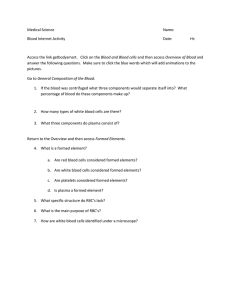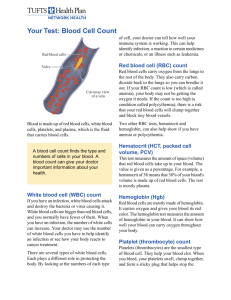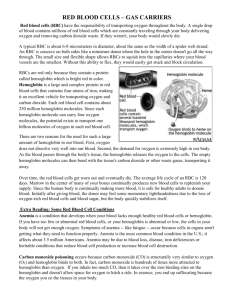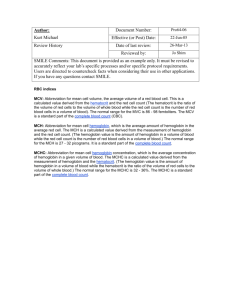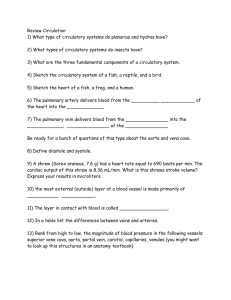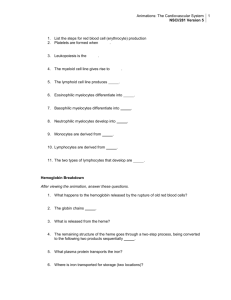Unit 3C Blood - Iowa State University
advertisement
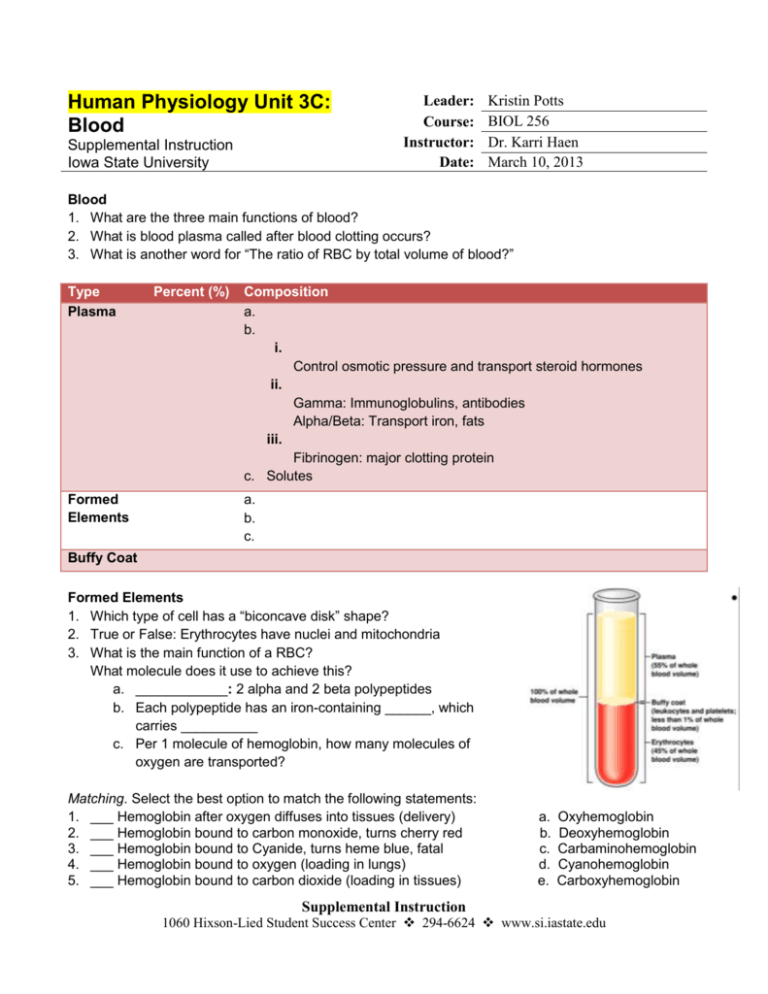
Human Physiology Unit 3C: Blood Supplemental Instruction Iowa State University Leader: Course: Instructor: Date: Kristin Potts BIOL 256 Dr. Karri Haen March 10, 2013 Blood 1. What are the three main functions of blood? 2. What is blood plasma called after blood clotting occurs? 3. What is another word for “The ratio of RBC by total volume of blood?” Type Plasma Formed Elements Percent (%) Composition a. b. i. Control osmotic pressure and transport steroid hormones ii. Gamma: Immunoglobulins, antibodies Alpha/Beta: Transport iron, fats iii. Fibrinogen: major clotting protein c. Solutes a. b. c. Buffy Coat Formed Elements 1. Which type of cell has a “biconcave disk” shape? 2. True or False: Erythrocytes have nuclei and mitochondria 3. What is the main function of a RBC? What molecule does it use to achieve this? a. ____________: 2 alpha and 2 beta polypeptides b. Each polypeptide has an iron-containing ______, which carries __________ c. Per 1 molecule of hemoglobin, how many molecules of oxygen are transported? Matching. Select the best option to match the following statements: 1. ___ Hemoglobin after oxygen diffuses into tissues (delivery) 2. ___ Hemoglobin bound to carbon monoxide, turns cherry red 3. ___ Hemoglobin bound to Cyanide, turns heme blue, fatal 4. ___ Hemoglobin bound to oxygen (loading in lungs) 5. ___ Hemoglobin bound to carbon dioxide (loading in tissues) a. b. c. d. e. Oxyhemoglobin Deoxyhemoglobin Carbaminohemoglobin Cyanohemoglobin Carboxyhemoglobin Supplemental Instruction 1060 Hixson-Lied Student Success Center 294-6624 www.si.iastate.edu Formed Elements Production 1. What is hematopoiesis? a. What is the term for RBC production? b. What is the term for WBC production? 2. Where are blood cells produced? 3. What hormone stimulates RBC production? Which organ releases it? 4. Which organs are responsible for breaking down old RBCs and heme? 5. Which molecules recycle the Iron from heme? 6. Heme is converted into what? How is it excreted? KNOW normal hematocrit and hemoglobin levels for a male and female! Male Female Hematocrit: Hematocrit: Hemoglobin: Hemoglobin: Erythrocyte Disorders __________: Blood with abnormally low oxygen-carrying capacity 1. Insufficient Erythrocytes a. ______________________: Result of a loss of blood b. ______________________: Prematurely ruptured erythrocytes c. ______________________: Destruction/Inhibition of red bone marrow 2. Decreased Hemoglobin Content a. ______________________: Inadequate intake of iron-containing foods b. ______________________: Deficiency of Vitamin B12 Supplemental Instruction 1060 Hixson-Lied Student Success Center 294-6624 www.si.iastate.edu 3. Abnormal Hemoglobin a. ____________________: Absent or faulty _________ chain in hemoglobin b. ____________________: Defective gene encoding for _____________ _______________: Increase in RBC, making blood viscous and increasing BP as a result a. ________________________: Bone marrow cancer b. ________________________: Decrease in Oxygen due to altitude c. ________________________: Athlete removes blood and saves for later use Leukopoiesis 1. Hormonally stimulated by which two families of cytokines? 2. From what type of cells do all WBC originate? 3. Hemocytoblasts differentiate into: a. Myeloid Stem Cells i. Myeloblasts ii. Monoblasts b. Lymphoid Stem Cells i. Lymphoblasts Blood Types 1. ______________ aka Antigens (Ag) expressed on blood cells 2. Two main systems: 3. ________________ spontaneously form against A, B or Rh antigen if not present on individual’s blood cells 4. _________________________: If mother is Rh- and fetus is Rh+, then mother’s antibodies attack fetus and results in a miscarriage Blood Type RBC antigen Serum Reaction Anti-A AB A B O Anti-B A and B A B None Supplemental Instruction 1060 Hixson-Lied Student Success Center 294-6624 www.si.iastate.edu
